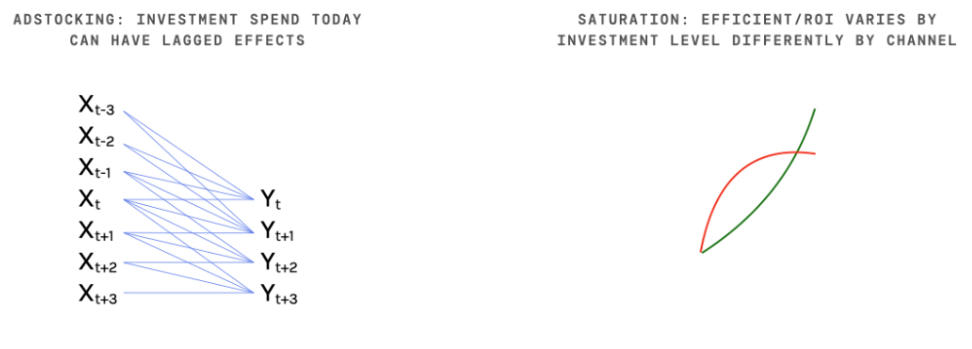Marketing Mix Modeling (MMM) is a powerful statistical approach that uses historical data to measure the impact of various marketing activities on a key performance indicator (KPI), such as sales or customer lifetime value (LTV), and then optimizes the allocation of future marketing budgets across channels. As the complexity of modern marketing increases, with consumers engaging with brands across multiple channels and devices, it has become more challenging to measure the impact of individual marketing activities on sales. This has led marketers to turn to MMM to gain a better understanding of how their marketing mix is contributing to sales, all while respecting customer privacy.
In this article, we will delve deeper into the mechanics of MMM and provide a comprehensive overview of its benefits, key concepts, and components, as well as discuss off-the-shelf and bespoke MMM solutions.
Overall, MMM provides several benefits for marketers, including:
- Improved ROI: By measuring the impact of individual marketing activities on sales, MMM helps marketers to optimize their marketing mix for maximum ROI.
- Increased Accountability: MMM provides a clear picture of the effectiveness of marketing activities, making it easier for marketers to justify their marketing spend to senior management.
- Real-Time Optimization: With the availability of real-time data, marketers can perform MMM on a regular basis and adjust their marketing mix accordingly. This allows them to respond quickly to changes in the market.
- Multi-Touch Attribution: In the ever-connected world, users often touch several marketing channels on their way to a purchase or sign-up. MMM can account for these complex causal graphs, giving credit to channels that are typically harder to assess, such as non-digital media.
- Privacy Friendly: Changes to tracking in iOS have hindered traditionally more direct and intrusive methods for measuring the effectiveness of digital advertising. Since MMM relies on aggregated sales data, it isn’t reliant on user-level data, such as PII or cookies.
- Reduced Human Bias: By automating decisions about adstocking, saturation, and seasonality, MMM reduces the influence of human biases in marketing decisions.
How Does MMM Work?
Two key concepts in MMM are adstocking and saturation.
Adstocking refers to the residual effect of a marketing activity on sales. In other words, the impact of a marketing activity on sales does not end immediately after the activity is completed. Rather, it continues to have an effect for a certain period of time, which is known as the adstock period. Adstocking is important for identifying synergies between channels and for accurately estimating the value created by non-digital media that typically has a delayed effect on users.
There are several commonly used methods for calculating adstock. The alternate formulation of the negative binomial probability mass function (PMF) is one method, which is intuitively parameterized through the timesteps since spend, \(n\) mean effect lag, \( \mu \) and the effect concentration around the mean, \( \phi \):

Saturation refers to the point at which further increases in marketing activity have diminishing returns. In other words, there is a limit to how much impact a marketing activity can have on sales, and beyond that point, increasing the marketing activity will not lead to a proportional increase in sales. Saturation is important for channels that saturate quickly, such as local print media.
The Hill Function is a biochemical equation commonly employed to represent saturation effects. In the case of MMM, a simple formulation is through channel efficiency (ROI or ROAS), and the channel spend at which point the efficiency is halved:


Focusing on marketing investment alone can lead to confounding and under- or over-estimating marketing ROI. By controlling for non-marketing demand and other causal factors, MMM can provide a more accurate picture of the impact of marketing activities on sales. A classic example of this is ice cream sales varying with the weather. In recent times, we have seen large changes in consumer behavior as a result of the COVID-19 pandemic that cannot be explained by marketing activities alone.
Pricing, product changes and market sentiment are among other basic factors to be considered. In effect, MMM creates a model for the business as a whole with marketing activities as only one aspect. Not only can this model be used to optimize marketing, but it can also be used to understand and optimize other business activities in relation to a shifting business environment.

MMM can also be performed at a regional level. Regions respond differently to marketing investment and natural variation in regional strategies can be leveraged to better estimate ROI curves for channels nationally and globally. Optimization can then be carried out at multiple geographical levels, making better use of local characteristic responses to marketing. Saturation is particularly important to estimate for regional marketing activities, since saturation has the greatest impact at the local level.
Off-the-Shelf Marketing Mix Modeling Tools
The popularity of MMM in recent years has prompted the open sourcing of off-the-shelf tools, such as Facebook’s Robyn and Google’s LightweightMMM.
Robyn is a mature model with a range of functionality and in-depth documentation. The MMM model is solved by a combination of ridge regression, for coefficients, and Facebook’s genetic optimizer, Nevergrad, for hyperparameters. A main strength is the breadth and quality of Robyn’s standard reports, which make it quick to understand experiment results and deliver results to the business. Robyn can also incorporate marketing calibration tests as additional data points to ground results.
However, Robyn is limited by its non-probabilistic nature. Prior knowledge, for example, of channel efficiencies, cannot be encoded into the model, leaving it up to the analyst to select the “best” of many final models produced by Robyn. This model selection step is difficult and allows for human bias to be introduced into the process. Additionally, the uncertainties provided for model results represent only a fraction of the true model uncertainty, making it hard to apply the appropriate level of caution when employing results in the business.
In contrast, LightweightMMM is a probabilistic (Bayesian) approach to MMM that allows users to incorporate prior knowledge into the model and provides a single model as its output, precluding any model-selection phase. Estimated model parameters, such as channel efficiencies, are provided as distributions, making it clear where large uncertainties lie, and propagating uncertainties to spend optimization. Another benefit of using LightweightMMM is its capacity for modeling geographic hierarchy, making it ideal for regionally restricted channels. The downside of LightweightMMM is its limited capacity for reporting, relying on the analyst to develop their own reports on top of the LightweightMMM API. Additionally, LightweightMMM is not an official Google product, meaning its continued development and support are uncertain.
Bespoke Marketing Mix Modeling
You might consider developing a custom MMM when (1) your business has access to the relevant technical skills internally or through a partner such as Strong, (2) there are specific marketing characteristics that your business needs to capture, and/or (3) there are limiting factors relating to infrastructure and computing environments.
A significant advantage of a bespoke MMM model is complete control over the model formulation. For example, if you have marketing activities at both regional and national levels, an existing off-the-shelf solution may not be flexible enough. Additionally, any MMM solution will need to integrate with existing data warehousing and BI reporting systems. The associated overheads can often justify developing something from scratch. However, if you are just starting your MMM journey, it may make more sense to first experiment with existing solutions, mapping out their strengths and weaknesses in your business context.
Should you decide to move ahead with bespoke MMM, a typical project would look like this:
- Exploratory Data Analysis: Collect and understand data for MMM. Identify if MMM is feasible and determine if it meets business requirements. Gain an understanding of the significant factors or structure that MMM will need to capture.
- Model Development: Develop the MMM model iteratively, collecting stakeholder input on results of the model at each step to guide necessary improvements.
- Productionization: Integrate the model into existing infrastructure, configuring the cadence of model refreshes. Create connections to data warehousing and external inputs. Standardize tabular and graphical outputs for BI reporting.
Validation
It is important to evaluate how accurately different MMM models perform in different scenarios. This can be achieved with real-world experimentation and using simulators. The results of these can be used to improve the model by tweaking the model specification and collecting additional data to fit against.
Real-world experimentation can be performed on historical hold-out data that the model is not trained on, or via modifications to future marketing spend. An example of this is a calibration test, where a channel is turned off for a period and the model’s prediction of resultant KPI changes are compared with observed.
Real world experiments provide a single data point each, while simulators can inexpensively explore innumerable scenarios, both realistic and hypothetical. A simulated approach additionally allows us to compare estimated and true “hidden” parameters, such as channel ROI, providing a more instructive view of model performance. This is because MMM models are often overdetermined and KPIs regularly contain more variance than channel spend, so typical metrics of model performance against the target ( \(R^2\), \(NRMSE\)) are less meaningful.
Summary
In summary, Marketing Mix Modeling (MMM) is a powerful analytical tool for measuring and optimizing marketing activities. With the increasing complexity and privacy-first nature of modern advertising, MMM is becoming an essential component of the marketer’s toolkit.
At Strong, we are helping clients understand and improve their marketing efforts using off-the-shelf solutions and our in-house MMM application. Implementing these as a continuous solution in their BI environments is allowing them to react to frequent changes in their respective markets. If you’re ready to add MMM to your toolkit to optimize your marketing strategy, reach out to us today!



